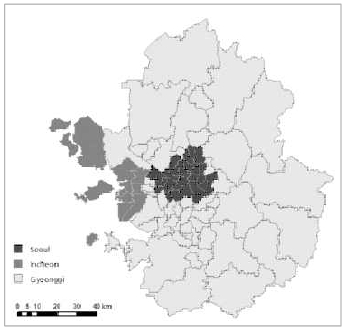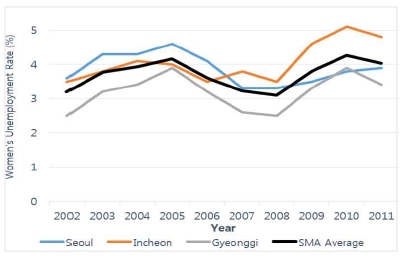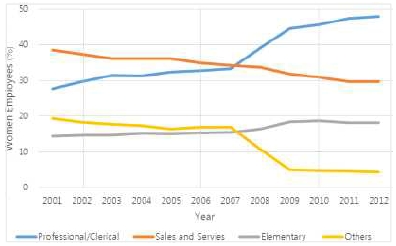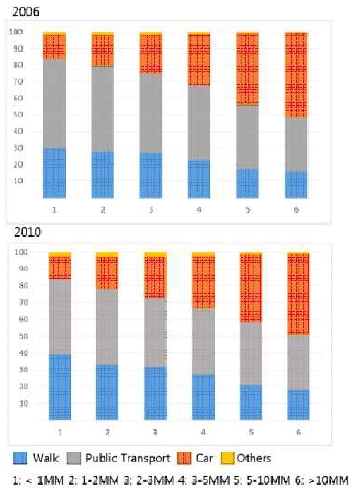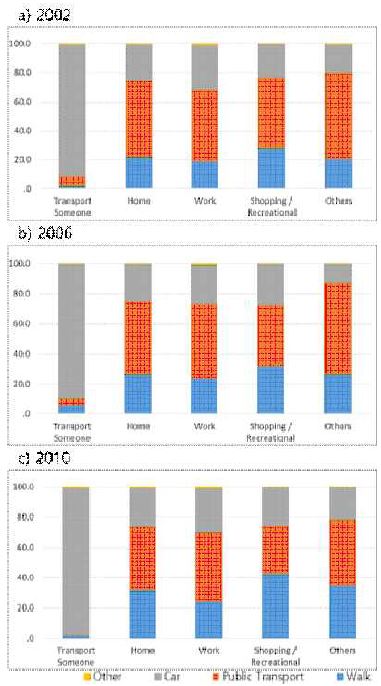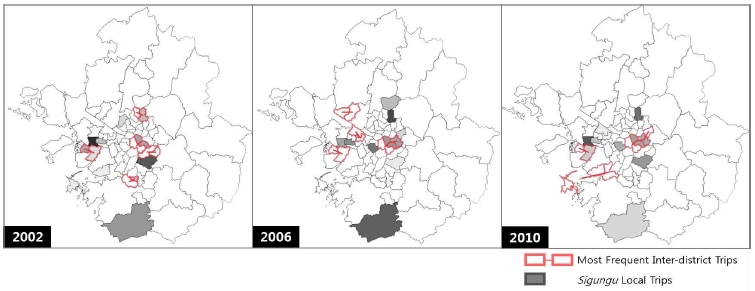
Final publication date 08 Nov 2017
Analysing Transition of Women’s Travel Patterns in the Seoul Metropolitan Area : Using Household Travel Survey Data in the 2000s
Abstract
The purpose of this study is to examine (1) the changes in women’s travel patterns and times and (2) women’s travel behaviour differentiated by their socio-demographic status. The main data for the analyses come from thee Household Travel Survey (HTS) for 2002-2010. This study compares behavioral differences between travel groups through t-test and ANOVA in addition to descriptive statistics as research methods. Those analyses are conducted in three perspectives: (1) understanding the economic and social trends in the 2000s that could have a relationship with women’s travel; (2) investigating various travel behaviours resulting from women’s personal and household characteristics; and (3) examining the relationship between place of residence and women’s travel. The analysis results suggest that there have been visible changes in women’s travel behaviour in terms of travel distance and time, while their accessibility ranges have not been expanded significantly. It appears that there is a clear difference between social classes in travel distance, time, and transportation mode. It is believed that this differentiation of female travel behavior is greatly influenced by the increasing socal change.
Keywords:
Women’s Travel Patterns, Seoul Metropolitan Area, BipolarisationⅠ. Introduction
It is suggested that the residential locations and urban forms in the neighbourhood significantly affect the accessibility1) of individuals (Prashker et al., 2008). There has been growing interest in how land use influences travel, activity, behaviour and possibly accessibility (Weber and Kwan, 2003). While, in earlier studies, urban forms and the spatial structure of cities were identified as factors affecting individual travel patterns, in more recent studies it has been suggested that individual accessibility is determined more by individual and household characteristics (Antipova et al., 2011). The latter approach sounds more persuasive regarding gender differences.
It has been suggested that women were disadvantaged in the transportation system in the past, as their travel needs were less considered compared to men, the head of household. (Singell and Lilydahl, 1986, Noh, 1998; Kim, 2007). They were bound to housework and childcare responsibilities and tended to be employed as part-time workers around the neighbourhood (Singell and Lilydahl, 1986). Most job opportunities for women did not require extensive professional skills (Crane, 2007). Consequently, women did not tend to travel far, and their modes of travel were mainly restricted to mass transit and walking (Hanson and Johnson, 1985).
However, remarkable changes in household income, the social status of women and their involvement in economic activities are thought to have changed the traditional gender disparity in the transportation system. For example, the improved status of women within their family might have encouraged women to own additional private vehicles to commute. In a similar vein, disparate commuting patterns might appear in varied forms over time. In order to verify these hypotheses, an empirical analysis that examines the effects of individual and household characteristics, such as age, job, mode of travel, income, number of family members and young children, number of vehicles and other factors is required.
The main purpose of this study is to analyse the transition in travel patterns by gender in the 2000s in the Seoul Metropolitan Area (SMA). The following three objectives are set to fulfil the main purpose: (1) to consider the travel time and distance trends in accordance with economic conditions and employment status; (2) to investigate personal and household factors that affect the changing travel patterns of various groups of women; and (3) to examine the characteristics of women’s most frequent trips.
Ⅱ. Previous Studies
The precedent studies mainly dealt with the following: (1) commuting characteristics caused by the economic status of households (single and dual-earner); (2) different travel behaviours between men and women; and (3) the characteristics of women's travel patterns. There are a number of studies that concentrate on the varied travel time, distance and mode of single and dual-earner households in SMA (Kang, 2008; and Jun and Kwon, 2015). For SMA, dual-worker households were likely to choose their residential place closer to the wife’s workplace, which allows the wife to have time to serve household roles.
The majority of previous studies examined the different travel behaviours of men and women, and possible factors that affect these patterns were evaluated (Rosenbloom, 2006; Crane, 2007; Kim, 2008; Lee et al., 2008; Sang et al., 2010; Antipova et al., 2011; McQuaid and Chen, 2012; and Yang and Lee, 2014). Their results seem to suggest that the socio-economic characteristics of each occupation type and number of children within a household plays a key role in the travel time and distance differences, as well as their gender differences. Also, the analysis result on the effects of parenting responsibility on men and women caused by the age of children showed that the accessibility difference is not caused by sex, but by gender2) and the roles related to gender (Kim, 2008).
There are also studies that are focused specifically on women’s travel patterns and investigated possible reasons for women’s shorter travel times (Blumenberg, 2000; Choi, 2005; and Sohn, 2010). The common reason suggested was that it is more likely for women to locate their jobs near their residence to balance household roles and their jobs. Other reasons also include: (1) feminised jobs could have been evenly distributed closer to residential areas, or (2) employers located near residential area intentionally hire women as they have greater availability (Blumenberg, 2000). On the other hand, Choi (2005) and Sohn (2010) concluded that shorter travel times could have resulted from women’s socio-economic status.
Overall, the findings of previous studies seem to imply that (1) men and women have different travel behaviour regardless of their different socio-economic backgrounds, (2) women tends to have shorter time and distance of travel, and (3) there have been noticable changes in women’s travel behaviour over time.
The majority of the previous studies employed data from a single year in examining women's commuting patterns and differences in accessibility according to gender (Kim, 2008; Son, 2010; Kwon and Jun, 2014). However, analysing a single year's data might be insufficient for understanding the changes in women's travel patterns caused by social changes. Therefore, this study intends to deal with the time period before and after women's active involvement in economic activity.
In addition, a number of previous studies have used Time-use Survey data sampled by Statistics Korea (Son, 2010; Kwon and Jun, 2014, etc.). As Time-use Survey focuses more on the usage of time and lifestyle priorities, it does not precisely investigate travel patterns. For that reason, this study has selected HTS data, which emphasise travel and commuting patterns.
A number of previous studies pointed out that urban forms and land use patterns also have certain effects on travel patterns of individuals, as well as their personal attributes (Crane, 2007; Sang et al., 2010; Antipova et al., 2011; Jun and Kwon, 2015). In this stance, this study would also focus on regional attributes of administrative district, sigungu, to see if there are any distinguishable spatial patterns in women’s travel behaviours.
Ⅲ. Study Area and Methods
This study intends to examine gender differences reflected in travel patterns from 2002 to 2010 (9 years) in SMA. SMA, which is approximately 11,805 km2, consists of Seoul and the neighbouring provinces of Incheon Metropolitan City and Gyeonggi Province. SMA is known to be the first to reflect social and economic changes occurring within the country.
The analysis is conducted on municipal level divisions, si, gun and gu (sigungu3)). The spatial scope includes 21 si, 4 gun and 53 gu from SMA as the study area (except the faraway islands of Ongjin-gun). The Household Travel Survey (HTS), the main data source, has been conducted every 4 years4). Therefore, the analysis employs three survey datasets: 2002, 2006 and 2010.
The HTS is collected by the Ministry of Land, Infrastructure and Transport (MoLIT). HTS data are collected every four years from 2.5% of the total population of SMA. The survey participants are asked to provide their household and personal attributes as well as their personal trip records on specific dates. In this sense, HTS is considered a very reliable source of data when analysing travel patterns.
This study is divided into three parts. The next section reviews previous studies and the relationship between economic conditions and travel behaviour, followed by a section on the data source and selection of variables, a section on analysis procedures and another section discussing the analysis results. The paper is concluded with a short summary of the results and implications. As part of the analysis, changing trends of women’s travel behaviour, their employment status and the personal and household factors that might affect women’s travel patterns are identified with sets of frequency analysis and Analysis of Variance (ANOVA). Lastly, the characteristics of the most frequent trips made by women are also investigated to further understand the patterns in women’s travel behaviour.
IV. Economic Conditions and Travel Behaviour
In order to understand the transition in travel patterns according to gender in the 2000s in SMA, (1) the relationships between travel behaviour, economic conditions and employment status and (2) the transitions in these aspects were examined.
Average travel time and travel distance were examined to find any travel behaviour changes in accordance with time flow (Table 1). Overall, men had longer travel times and greater travel distances than women from 2002 to 2010. Regarding travel pattern changes, women, on average, travelled for the longest time in 2010 compared with previous years, while the distance they travelled was not the greatest in 2010. This might imply that there was a notable change in women’s areas of activity and their accessibility.
The changes in economic conditions, especially in employment status, are known to be closely related to individuals’ travel behaviour. They are one of the factors that affect the residential location choices of individuals, which could again have impacts on modal choice and travel patterns. High travel cost and greater travel distance could be acceptable for more stable job opportunities (Rosenbloom, 2006).
This structural change of employment status in the 2000s was observed by an increased unemployment rate and changes in the labour market in terms of job classification. In order to understand the relationship between women’s employment conditions and their travel behaviour, the transition in women’s position in the labour market was examined in advance.
From 2006 to 2010, the unemployment rate increased dramatically due to economic crisis in 2008 (Figure 2a). It is reported that fixed-contract part-time employment increased in all age groups of women (Kim, 2012).
In addition to unemployment rate changes, the labour market conditions in terms of women’s employment could be considered in depth (Figure 2b). From the late 1990s to early 2000s, a significant transition was found due to two main causes: (1) heavy economic decline and (2) a structural change in the labour market. The economic downturn in the late 1990s caused women to enter the labour market, especially married women, to share the economic burden of their household. For instance, in the early 2000s, the number of female employees in the services and retail sector on fixed-term contracts was sustained until around 2003 (Chae, 2002; Hwang, 2014), which declines in the later stage. Along with their forced entrance into the labour market, highly educated women became willing to enter the professional and clerical fields of the labour market. The number of female employees progressively increased (Hwang, 2014), but at the same time it caused bipolarisation in the labour market regarding job quality and income (Nahm, 2011).
This transition is similar to the trend shown in the US in the early 2000s discussed by Rosenbloom (2006), and it is noticeable that women’s active involvement in the economy consequently triggered a transition in their travel behaviour. In particular, it is interesting to see the increase in economic involvement of women with children, as many previous studies have reported that women with children have relatively smaller accessibility due to parenting responsibility (Choi, 2005; Crane, 2007; Kim, 2007, 2008; Sohn, 2010; etc.).
V. Analysis
1. Analysis Framework
The variables for the analyses were determined based on (1) the findings of previous studies and (2) data available from the HTS. HTS data are composed of three attributes: household, personal and individual trips. Table 2 summarises the variables considered in previous studies.
The following is the procedure for determining dependent variables, travel time and distance5). Firstly, the cases with origins or destinations outside SMA were eliminated from the analyses. Travel time was calculated by subtracting the departure time from the arrival time, as indicated in the survey responses. As the exact locations of trip origin and destination are not mandatory required information in the HTS, the majority of the cases did not provide both origin and destination. Consequently, the centroids of each sigungu were assumed to be the origin and destination. The equations for calculating inter-provincial trips and sigungu local trips are as of Equations 1 and 2.
In order to validate the use of distance between sigungu-centroids, the travel distances of the cases with at least one exact known origin and/or destination were calculated and compared. There were three groups available in this aspect: the cases with (1) both the exact origin and destination provided; (2) either the exact origin or destination provided; and (3) both the origin and destination unknown (sigungu-centroids used). The average distances of the three groups did not show a great difference6). Therefore, the distance between the sigungu-centroids was considered acceptable.
2. Analysis of Personal and Regional Attributes and Travel Behaviour
(1) Overview
It is reported that the mode of travel that men and women adopt is distinct, as reflected in their travel behaviour. In this part, the differences between men and women in terms of the mode of travel they use are examined. Several previous studies (Crane, 2007; Antipova, et al., 2011; Yang and Lee, 2014) have reported that household income and number of children have significant effects on women’s chosen mode of travel. Therefore, the relationships between the variables are considered important in previous studies and women’s mode of travel is investigated.
Overall, private vehicles were men’s main mode of travel, while women relied mostly on public transport (Table 3). About half of the men’s group drove their private vehicle to work, although the percentage decreased from 2002 (57.4%) to 2010 (49.5%). On the other hand, a similar portion of women were using public transport (bus, subway or taxi) as their major mode of travel, which distinctly decreased from 2002 (52.1%) to 2010 (40.9%).
The main findings from looking at modes of travel are: (1) an increase in women using private vehicles as their mode of travel and (2) a relatively higher and increasing portion of women traveling by foot. In the comparison of men’s and women’s usage of private vehicles from 2002 to 2010, the usage of men decreased, while women showed a pattern of increased usage. Nevertheless, a relatively high portion of women still travelled by foot. The percentage of women traveling by foot increased by about 9%, while their usage of public transport decreased by about 12%. It could be inferred that there has been a meaningful travel mode shift from public transport to walking, and a considerable number of women’s trips are still being made in the neighbourhood.
In addition, the mode of travel chosen for work-related trips was examined. From 2002 to 2006, the use of private vehicles decreased, while walking increased. The modal choice for 2010, however, became polarised between women driving and walking to work. The use of public transport decreased, while the use of private vehicles increased. It is possible that women at a high-income level with relatively more stable jobs started to drive to their workplace, whereas women at a lower income level might have changed their mode to walking instead of public transport. In this sense, it is quite inadequate to generalise women’s travel behaviour when the differences are recognisable. This implies that an additional analysis is needed based on class.
(2) Modes of Travel and Private Vehicles Owned by Households
It has been shown that women travelling by private vehicles has increased over time. In particular, this change was not provoked by households started to own more vehicles than before, rather the average number of cars owned by households has decreased in 2006 (0.83 cars) and 2010 (0.85 cars) compared with 2002 (0.96 cars). Also, the portion of households without cars have increased by approximately 8% over time. It could imply that instead of men in family drives there car, there have been cases where women took charge of the only car in the households. This could be interpreted as owing to two factors: women’s relatively improved position and the extension of their roles within households.
To identify whether the number of cars owned by each household is significant in determining women’s travel patterns, sets of ANOVA tests have been conducted. Both travel time and distance had statistically significant differences (p < 0.05) according to number of cars (Appendix 1).
In general, groups with more cars had the least travel time, while travel distance increased. This could be understood as: women having (1) more opportunities to use private vehicles for their trips, possibly to work and to travel to other destinations or (2) linked trips to serve household needs as before.
The former could be explained as women having more opportunities to travel further in a shorter period time with the aid of private vehicles, as they have more opportunities to utilise them. This might have provided more possibilities for women to work further away from home or to socialise and shop not only in the neighbourhood but further away than before. This implies that women have an improved position within their family.
On the other hand, the latter could imply that women are still bound by household responsibilities extended from their work. For a long time, women have had many household responsibilities that require trips of a certain length. The responsibilities include picking up and dropping off their children, shopping for groceries and taking care of the elderly. Private vehicles in the household might have been used by women for efficient and safe trips in carrying out these activities.
(3) Modes of Travel and Household Income
The relationship between mode of travel chosen and household income was considered. The difference in women’s travel mode choices was examined by using household monthly income, which is collected in HTS as a household attribute. As the 2002 HTS has a different income range from that in the 2006 and 2010 HTS, the latter two datasets were selected for the analysis.
The household monthly income explains the disparity in women’s travel mode choices. Lower income groups chose public transport and walking as their main travel modes. As the household income increased, however, generally, the use of private vehicles increased, while the portion of women walking and using public transport decreased. In this respect, there is a considerably large gap between income groups 3 and 4, where the change is noteworthy. Higher income groups used private vehicles as their main mode of travel (approx. 50%), while a relatively smaller portion chose walking compared with the other income groups. The characteristics of higher income groups of women, therefore, are more similar to men’s travel behaviour, as Sohn (2010) indicates. The gap between women’s household income groups might reflect the bipolarisation in women’s modal choices. That is, the increased use of private vehicles could be understood as the result of an increase in women’s social status compared with the past. However, as shown in Figure 3, this approach is persuasive only for higher income groups. Figure 3, in contrast, shows that lower income groups still heavily rely on walking and public transport.
In terms of women’s travel, the 2006 and 2010 HTS data show similar patterns. As mentioned above, all income groups showed an increased amount of walking in 2010, and private vehicles either decreased or stayed the same in the comparison between 2006 and 2010. For this reason, it could be comprehended that the differences in women’s change of mode result from household income. For the 2006 and 2010 HTS, the difference in women’s modal choices by household income groups was identified by ANOVA. In the analysis, mode of travel was rearranged by travel cost to form an ordinal scale, with walking as the lowest rank and private vehicles as the highest rank. The ANOVA result shows that household income has a statistically significant effect on the modal choices of women (p < 0.05, Appendix 1).
(4) Modes of Travel and Number of Children
In this section, the relationship between mode of travel and number of children is examined. Childcare has been considered one of the major household roles of women for a long time. Working women with children aged 6 or under tend to travel shorter distances than men and women with older children (Kim, 2008; Mcquaid and Chen, 2012). Therefore, previous studies have reported that number of children is a crucial factor that affects women’s travel behaviour (Kim, 2007, 2008; Sohn, 2010). The number of children is categorised into three groups: no children (group A), 1 child (group B) and 2 or more children (group C). This section particularly considers new-borns to pre-schoolers, as the HTS data only surveys children under the age of 7. In 2002 and 2006, the women using public transport as their main mode of travel constituted the greatest portion (Figure 4). Considerable changes are visible in 2010; the use of public transport decreased, while walking and driving increased in all three groups. In groups B and C especially, walking and driving constituted a relatively greater portion compared with in group A. This might be another indication of bipolarisation in women’s travel patterns.
The purposes of travel were divided into five categories: (1) transporting someone (i.e. picking up and dropping off); (2) home as the destination; (3) work as the destination; (4) shopping and recreational; and (5) others. The distribution of travel purpose by gender is examined (Table 5). Except home travel, men engaged in work-related travel the most, while women had other purposes for their travel.
To examine women’s travel behaviour, travel mode choice by purpose was observed (Figure 5). For the purpose of transporting someone, women’s use of private vehicles constituted the highest portion, especially in 2010 (97.4%).
Regarding the personal attributes of those transporting someone as their purpose, the average age was 38 and 73.7% of them were in their 30s. Hence, this pattern might be related to dropping off and picking up their family members either at their destination or at a place of public transportation. It is quite common in Korea, like in every other developed country, for mothers to pick up and drop off their children during their school hours. Wives may give a lift to husbands to desirable mode of public transport when affording a second car is difficult for them. From this, we can see that the change in women’s modes of travel results from women’s traditional gender role (i.e. involving housework and childcare) rather than women’s social status improvement.
The portion of women working in the professional and clerical fields increased greatly between 2000 and 2010. On the other hand, the men working in the sales and service industry sector increased considerably in the same period. This shift in the employment paradigm is one of the indications that women’s social status improved in the early 2000s.
In the professional and clerical sector, the degree of change in travel time has been relatively gradual (Figure 6). It could be suggested that the professional and clerical sector has a relatively higher wage and more stable employment conditions than other sectors. On the other hand, women employed in the sales and service sector display greater differences in average travel time changes compared with those employed in the professional and clerical sector.
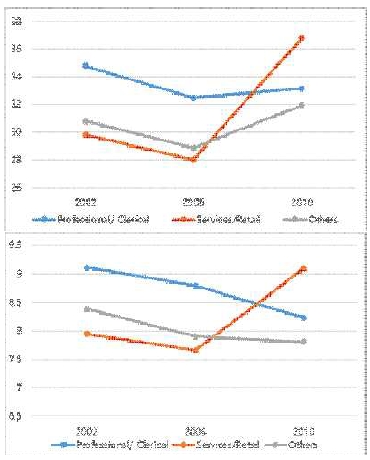
Women’s Changing (a) Travel Time Most Frequent Inter-District Trips and Sigungu-local Tripsand (b) Distance by Occupation Type
In addition, they have rather unstable employment status. This could imply that economic changes have different impacts on individuals according to their occupations. The sales and services sector may have been affected more by the changing economic conditions compared with the professional and clerical sector. In this sense, people who belong to the sales and services sector may tend to pay more travel costs in order to acquire more secure jobs, which leads to greater travel distance and time. The disparity between men and women has been decreasing in the labour market since the early 2000s. This has been generally understood as an improvement in women’s employment conditions due to their increased educational level and their ability to handle tasks in more professional sectors. However, it could instead be a result of the labour market losing the balance within society, meaning that job quality, as a whole, has been decreasing due to unstable economic conditions. Both women and men have gradually switched to part-time from full-time work (Lee, 2004). This decrease has had more effects on men, as they are the majority occupying the job market. This change, therefore, conflicts with the previous studies reporting improved social status of women. In terms of this, from the mid-2000s, the portion of men working in the service and retail sector has been increasing, which could also be seen as the result of the unstable job opportunity supply throughout society. This means that the quality of available jobs decreased, although the number of available jobs could have increased quantitatively.
Furthermore, the relationship between women’s employment and the number of children was examined. In order to explain the results more clearly, as mentioned above, the number of children is divided into three groups: no children (group A), 1 child (group B) and 2 or more children (group C) and jobs are also categorised into three groups (professional/ clerical, sales/services and others). The results show several interesting points; of which some are in disagreement with previous studies. Regardless of their job classification or number of children, the groups do not show much travel time difference.
This might imply a distinctive characteristic found in recent Korean society: children are looked after mostly by grandparents or childcare services so that the mother can continue their career without any disruptions (Beck, 2013). Statistics show that about 50.5% of dual-earner households ask their parents to take care of their children during weekdays (KBS News, 2014; KMIB, 2016).
The ANOVA was carried out to further examine the effect of children on women and whether there are differences among the three groups with no children (group A), 1 child (group B) and 2 or more children (group C). The results show that there is a statistically significant difference for average travel time and distance (p < 0.05), meaning that the number of children aged below 7 could affect the travel patterns of women differently (Appendix 1). In most cases, women without children aged below 7 had the greatest time and distance travelled. This could imply that children have a negative effect on women’s potential to travel further from home.
It has been suggested that residential area has certain effects in the differentiating travel patterns of individuals (Baumvol, 2014; Jun and Kang, 2009; Yang and Lee, 2014). The regional characteristics in women’s travel patterns were examined in two ways: (1) the travel patterns of women in three provinces, Seoul, Incheon and Gyeonggi, of SMA are examined at the regional scale, and (2) at the district scale, the most frequent routes of travel of women were investigated to see if there were any distinguishable spatial patterns.
The travel distance and time of women living in three provinces were first compared to investigate whether the residential area resulted in different travel patterns (Table 6). In sequence, the travel time and distance of men were used to compare women’s behaviour. It was found that women from Seoul had the longest travel time, while women living in Gyeonggi travelled the greatest distance.
For men, similar patterns were found. Both gender groups had a period of low activity in 2006, but this increased again from 2006 to 2010. Additionally, the ANOVA test was conducted to see if there is a significant difference between the travel time and distance for women living in provinces. The result shows that the difference is significant (p < 0.05, Appendix 1). This result also supports the theory that women’s travel patterns might not be homogenous and reflect the regional attributes of their residential area.
For instance, both men and women living in Seoul have a shorter average travel distance due to Seoul being at the centre of SMA. On the other hand, those in Incheon and Gyeonggi have a shorter average travel time, although they are highly dependent on Seoul, as the public transportation system and highways connecting Incheon and Gyeonggi to Seoul have been improving (Choo, 2011).
To be more specific, the most frequent inter-district trips and sigungu-local trips of women were investigated to determine the relationship between residential area and women’s travel behaviour. The 10 most frequent travel routes are listed and were mapped using QGIS 2.12 (Figure 7).
The region with the most frequent women’s sigungu-local trips had three distinctive characteristics: (1) well-established business districts, (2) concentrated industrial complexes and (3) an accessible transportation network. On the other hand, the 10 most frequent inter-district trips were all made to adjacent sigungu. This could suggest that the movement range of women living in SMA has not been greatly expanded compared with in the past. This is in agreement with Kim’s (2008) result that women still have limited access to ‘urban opportunities’ due to their gender roles.
Interestingly, the frequent routes had a concentrated portion of women with specific occupations. Women in professional sectors were traveling from and to the south of Seoul, the most thriving business district of SMA, while women working in the sales sector were concentrated in the parts of SMA where industrial complexes are accumulated.
Ⅵ. Conclusion
The objective of this study was to analyse the transition in travel patterns by gender in the 2000s in the Seoul Metropolitan Area (SMA). The following three objectives were set to achieve the main purpose: (1) to consider the trends in travel time and distance in accordance with economic conditions and employment status; (2) to investigate personal and household factors that affect the changing travel patterns of various groups of women; and (3) to examine the characteristics of women’s most frequent trips.
The HTS data collected from MoLIT in 2002, 2006 and 2010 were used to analyse women’s travel behaviour based on the findings of previous studies. The results of this study suggest a number of points. Firstly, men and women have different travel patterns, and women’s travel patterns have changed with time. Additionally, women possess different travel behaviours according to their socio-demographic characteristics. Therefore, it might be too soon to draw the conclusion that women possess a homogeneous travel pattern. Lastly, although the travel time and distance increased for some groups of women, their movement ranges have not yet expanded substantially. In this perspective, it would be difficult to agree that women’s social status has improved by looking at their travel behaviour alone.
The significance of this study may include: (1) the examination of the travel patterns of women living in SMA over a period of time to support the theory that their travel behaviour has been changing; (2) the investigation of different travel behaviours of women according to their socio-demographic status and (3) the suggestion of the existence of polarity in women’s travel patterns according to their socio-demographic status. Although the study has achieved its aims, there were some unavoidable limitations. The data used in the analysis are in the macro scale and aggregated to understand the overall travel patterns of women living within a reasonably great spatial scope rather than reflecting the travel pattern variability of individuals in the micro scale. Moreover, apart from sets of ANOVA analyses, sophisticated quantitative models were not applied in this study to derive more refined findings. Nevertheless, the results of this study may be applicable as practical information for transportation planning and women’s studies.
Acknowledgments
이 논문은 한양대학교 교내연구지원사업으로 연구되었음(HY-2015년도)
Notes
References
-
Antipova, A., et al., (2011), “Urban Land Uses, Socio-demographic Attributes and Commuting: A Multilevel Modeling Approach”, Applied Geography, 31, p1010-1018.
[https://doi.org/10.1016/j.apgeog.2011.02.001]

- Baumvol, BM., et al., (2014), “Gender Differences in Children Escorting Practices among Dual-earners Families in the Paris Region”, Women’s Issues in Transportation, 2014, p1-15.
- Beck, S., (2013), “Major Characteristics and Policy Implication of Grand-parenting in Gyeonggi Province”, Gyeonggi Province Economic Trends, 156, p1-16.
-
Blumenberg, E., (2000), “Moving Welfare Participants to Work: Women, Transportation and Welfare Reform”, Affilia, 15(2), p259-276.
[https://doi.org/10.1177/08861090022093976]

- Chae, G., (2002), “An Analysis of the Causes of Nonstandard Employment Increase after the IMF. Economic Crisis”, Korean Journal of Sociology, 36(5), p143-169.
- Choi, M., (2005), “Study on the Commuting Behavior and the Way of Home-workplace Linkage of Working Women in Seoul”, Master’s Degree Dissertation, Seoul National University.
- Choo, S., (2011), “Exploring Characteristics on Travel Time Budget: A Case Study of Seoul Metropolitan Area”, Journal of the Korean Urban Administration Association, 24(2), p3-21.
-
Crane, R., (2007), “Is There a Quiet Revolution in Women’s Travel? Revisiting the Gender Gap in Commuting”, Journal of the American Planning Association, 73(3), p298-316.
[https://doi.org/10.1080/01944360708977979]

- Hanson, S., and Johnson, I., (1985), “Gender Difference in Work-length”, Urban Geography, 6, p193-219.
- Hwang, Y., (2014), “A Study on Development of Women's Employment Policy in Korea”, Ph.D. Dissertation, Ewha Women’s University.
- Jun, M., and Kang, C., (2009), “Analysis on Commuting Travel Behavior of the Dual-worker Households in the Seoul Metropolitan Area”, Journal of Korea Planning Association, 44(3), p193-206.
-
Jun, M., and Kwon, K., (2015), “Why Dual-Earner Households in Seoul Live Closer to the Wife's Workplace than the Husband's?”, Urban Policy and Research, 33(2), p1-16.
[https://doi.org/10.1080/08111146.2014.994739]

- Kang, C., (2008), “Analysis on the Household Characteristics and the Commuting Travel Behavior of the Dual-worker Household in Seoul Metropolitan Area, Master’s Degree Dissertation, Chung-ang University.
- KBS, (2014), “Grand-parenting Increases: Left with Health Problem”, 2014.03.24, news.kbs.co.kr/.
- Kim, H., (2007), “Gender, Roles, Accessibility and Gendered Spatiality”, Journal of the Korean Geographical Society, 42(5), p808-834.
- Kim, H., (2008), “Women’s Spatial-Temporal Entrapment in Access to Urban Opportunities by Child Age”, Journal of the Korean Geographical Society, 43(3), p358-374.
- KMIB, (2016), “Solutions for Involuntary Grand-parenting?”, 2016.01.17, news.kmib.co.kr/.
- Korea Transport Database, (2016), “Announcement on 2016 National Transport Surveys”, 2016.04.22, www.ktdb.go.kr/.
- Kwon, K., and Jun, M., (2014), “An Analysis on the Gender Differences of Life Time Use and Travel Mode of Seoul`s Dual-Worker Households Using Time-Use Survey Data.”, Journal of the Korean Regional Science Association, 30(3), p109-129.
- Lee, C., (2004), “The Changing Employment Structure and the Women's Economic Participation”, Journal of Social Science, 30(1), p81-102.
- McQuiad, R., and Chen, T., (2012), “Commuting Times - The Role of Gender, Children and Part-time Work”, Research in Transportation Economics, 34, p66-73.
-
Prashker, J., et al., (2008), “Residential Choice Location, Gender and the Commute Trip to Work in Tel Aviv”, Journal of Transport Geography, 16, p332-341.
[https://doi.org/10.1016/j.jtrangeo.2008.02.001]

- Rosenbloom, S., (2006), “Understanding women and men's travel patterns: The research challenge. In Research on Women's Issues in Transportation, Vol. 1”, Paper presented at Transportation Research Board Conference Proceeding 35, Washington DC, National Research Council.
- Singell, L., and Lilydahl, J., (1986), “An Empirical Analysis of the Commute to Work Patterns of Males and Females in Two-Earner Households”, Urban Studies, 2, p119-129.
- Son, M., (2010), “The Gender Differences of Travel Behavior in the Seoul Metropolitan City: Analysis of Time Use”, Korea Journal of Population Studies, 30(1), p1-25.
-
Weber, J., and Kwan, M., (2003), “Evaluating the Effects of Geographic Contexts on Individual Accessibility: A Multilevel Approach”, Urban Geography, 24(8), p647-671.
[https://doi.org/10.2747/0272-3638.24.8.647]

- Yang, J., and Lee, S., (2014), “Why Women’s Commuting Time is Shorter? A Study on Gender Differences in Commuting”, The Journal of Women and Economics, 11(1), p161-184.
